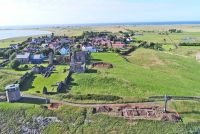The second summer season of the Peregrini Lindisfarne Community Archaeology project on Holy Island has been successfully concluded with spectacular results.
In addition to the significant and well publicised discovery of the foundations of a possible early Anglo-Saxon chapel on the crown of The Heugh, other exciting remains were uncovered in the vicinity.
To the west of the chapel, close to the existing war memorial, further investigation was carried out on the remains of a substantial stone-built platform structure partially uncovered last year, which has been tentatively identified as the base of a tower, again possibly of Anglo-Saxon date. Mortared into the south face of the platform structure, which consisted of a single course of rough cobbles, the excavators discovered a socketed stone, thought to be a reused stone cross-base, and an external surface of small rounded cobbles in the same area. The presence of a cross-base suggests the possibility that the platform feature may have originally been the site of a ceremonial cross.
The Lantern Chapel, at the west end of The Heugh, was also investigated. This has been a poorly understood building and, in its current form, bears little resemblance to a chapel, although a chapel-like structure is depicted in this position on a map of the island dating from 1548. Excavation here seems to have confirmed the existence of this chapel by uncovering the footings of an east-west wall sitting directly upon the natural bedrock, apparently the remains of an older, narrower building on an east-west axis beneath the visible walls. A grave had been cut into the bedrock within the chapel and the disturbed remains of several individuals were found above it, but left undisturbed.
Although the dates of construction and use of the three major structures excavated on The Heugh in 2017 remain unclear, it is likely that they represent a long period of sacral activity and it is hoped that the analysis of samples taken from all three sites will provide significant additional information in the coming months.
In addition to the cultural heritage of The Heugh, the natural environment has also been studied and appreciated as part of the wider Peregrini Lindisfarne project, which has been made possible by National Lottery players thanks to a £1.37m grant from the Heritage Lottery Fund (HLF). The whin bedrock upon which two of the excavated structures are founded has been studied by geologist Ian Kille, while the plants and animals of The Heugh and its southern shore are as inspiring now as they were to St Cuthbert and his contemporaries. Prior to this season’s excavations, the natural environment had already given some clues to the hidden secrets of The Heugh, when a botanist working on the Peregrini Whin Grassland project recently questioned why different non-whin type plants were present on parts of The Heugh; the archaeology project has answered this question, showing that these plants were growing over the sandstone chapel.
This season’s work on and around The Heugh has confirmed the importance of Holy Island in terms of its natural history and cultural heritage which combine to produce a unique and inspiring landscape. Conservation Manager, Sara Rushton said: "The results of this year’s excavations on The Heugh have exceeded all our expectations and will cause us to radically re-think how this narrow, exposed rocky ridge was used in the medieval and early-medieval period. These discoveries will make an important contribution to our understanding of the development of the monastery on Holy Island."
The significance of the archaeology and the national importance of the natural environment will require a careful balancing act and much thought as to how best to holistically manage both. The archaeological sites have been temporarily backfilled and the nationally important habitat restored in order to give the community and other stakeholders time to develop a new project to look at, interpret and manage the whole Heugh - a real legacy for the Peregrini Lindisfarne project.
Peregrini is a landscape partnership project made up of community, voluntary and public sector organisations. The project has received £1.37m funding through the Heritage Lottery Fund and is part of their national Landscape Partnership Programme. Partner’s funds and other grants dictate that over the next three years the £1.82million project will fund a wide variety of conservation and engagement projects on Holy Island and the adjacent mainland.
The Peregrini Lindisfarne Landscape Partnership Scheme is managed by a Partnership of professional and community representatives from Holy Island and surrounding shore side area. The lead organisation for the Scheme is the Northumberland Coast Area of Outstanding Natural Beauty (AONB) Partnership, hosted by Northumberland County Council.
Councillor John Riddle, cabinet member for planning at the county council said: "It is fantastic that this archaeology project is unearthing such significant remains on Holy Island, confirming the importance of the area in terms of its natural history and cultural heritage. I look forward to hearing the results of the further analysis of samples that have been taken from the three sites and to see what additional information this will provide."
Photo: Aerial shot of the chapel, courtesy of The Archaeological Practice
Photo: Aerial shot of the chapel, courtesy of The Archaeological Practice
View the full article at Northumberland County Council
Report News Article




Recommended Comments
There are no comments to display.
Create a free account or sign in to comment
You need to be a member in order to leave a comment
Create an account
Sign up for a new account in our community. It's easy!
Register a new accountSign in
Already have an account? Sign in here.
Sign In Now